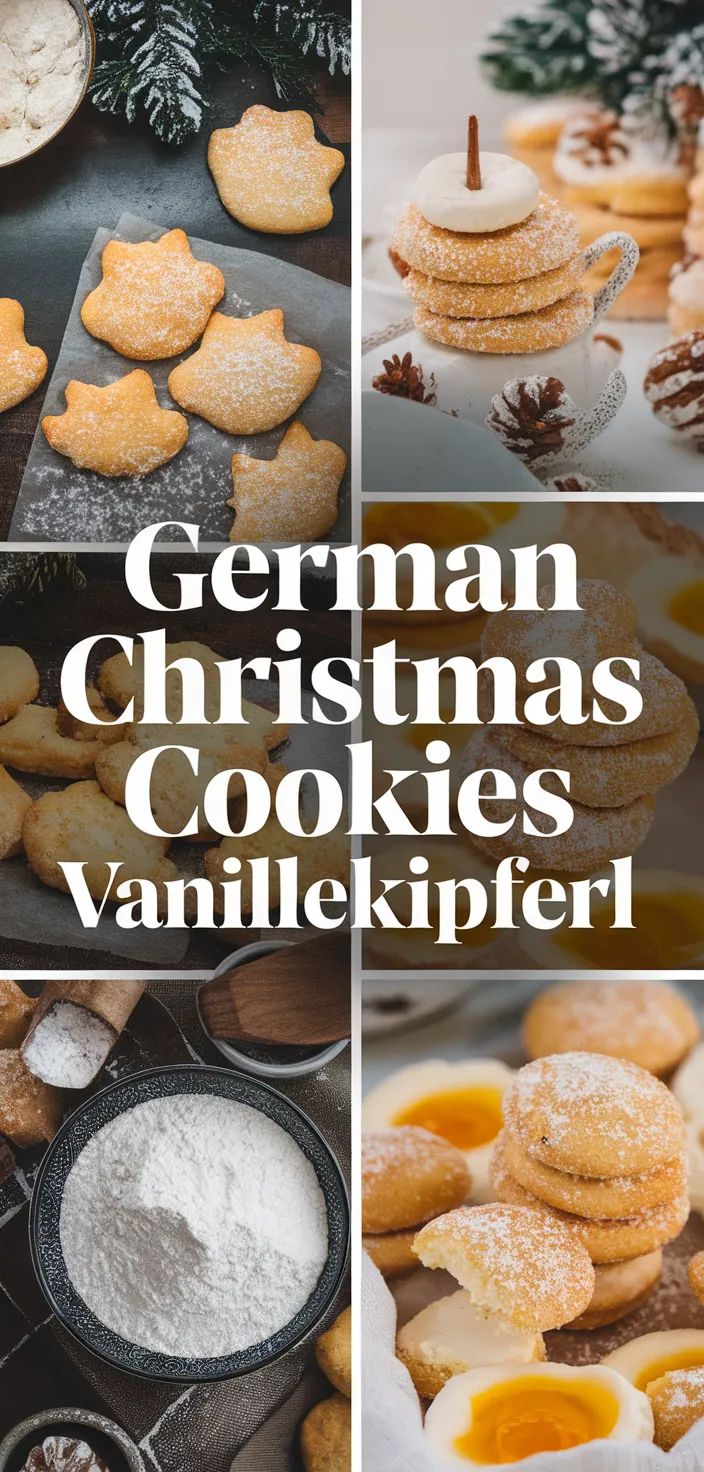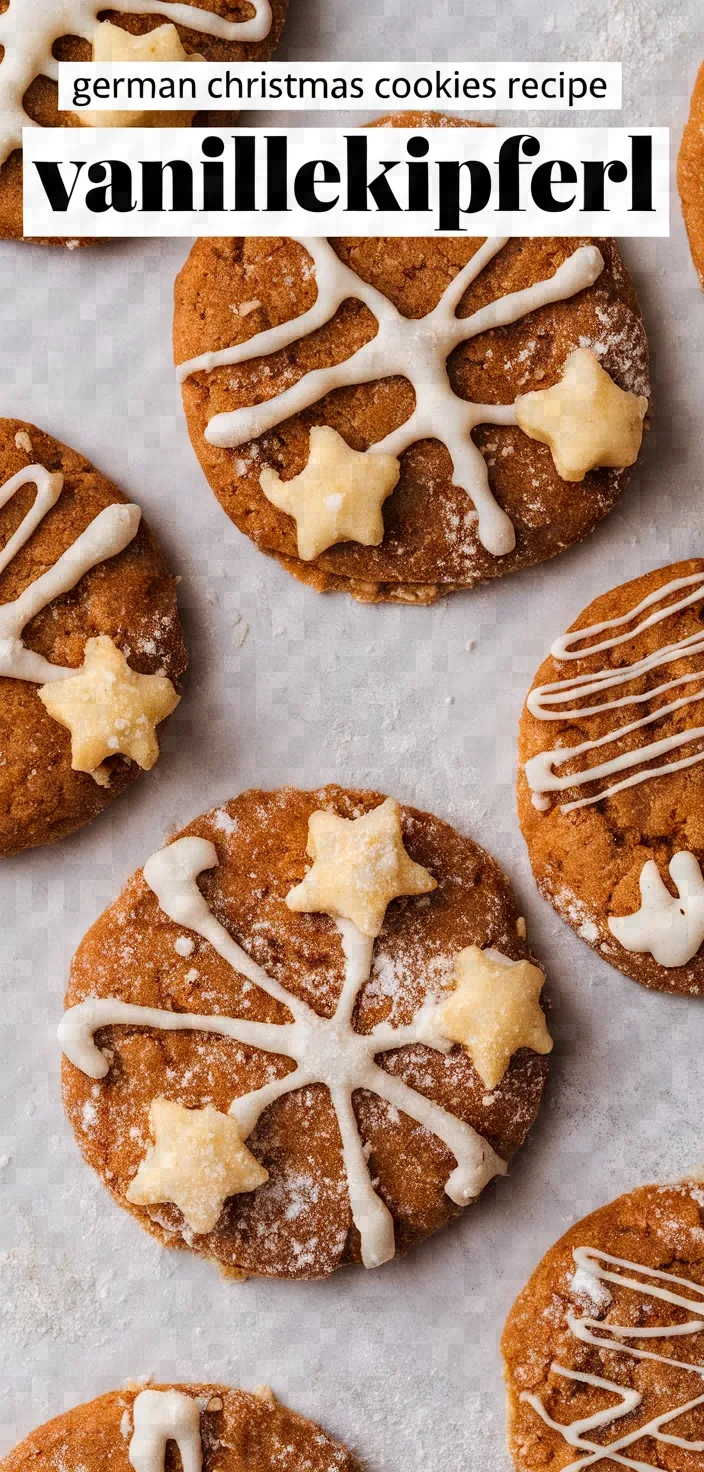I absolutely love this recipe because it combines the nostalgia of homemade baking with the elegance of delicate vanilla crescents, which always manage to impress my friends at brunch. Plus, there’s something incredibly satisfying about rolling these buttery treats in vanilla sugar while they’re still warm – it’s like a sweet little zen moment in my kitchen.

A beloved German Christmas pastry, vanillekipferl brings together the flavors of ground almonds and a buttery dough. I appreciate the mix of 250g of all-purpose flour and 200g of cold, unsalted butter that forms the delicate texture.
There’s 70g of granulated sugar and a packet of vanilla sugar, too, which appear to be the secret to making these crescent-shaped cookies taste like cookie-version of a vanilla cloud. They’re not overly sweet.
Instead, they taste like what a Christmas cookie is meant to taste like: a sweet, rich little something that nudges you back to your childhood.
Ingredients

– All-purpose flour: Its gluten content gives the cookies structure.
– Almond flour: Contributes a unique flavor and natural sweetness, is very high in healthy fats, and also offers copious amounts of vitamin E and magnesium.
– Sugar, in granulated form, provides sweetness to the dough and produces the tender-but-firm cookies.
– Sugar vanilla: Imparts the flavor of vanilla and boosts the cookie’s already-heady bouquet.
– Unsalted butter: Adds richness and flakiness to the texture.
– Egg yolks: Help to hold the ingredients together and impart a rich, creamy flavor.
– Confectioners’ sugar: Used for dusting, provides a soft, sweet touch to the cookies.
Ingredient Quantities
- 250g all-purpose flour
- 100g ground almonds
- 70g granulated sugar
- 1 packet vanilla sugar (equivalent to about 8g)
- 1 pinch of salt
- 200g unsalted butter, chilled and cut into small pieces
- 2 egg yolks
- 100g powdered sugar
- 2 teaspoons vanilla sugar (for coating)
Instructions
1. In a large mixing bowl, combine the flour, ground almonds, granulated sugar, 1 packet of vanilla sugar, and a pinch of salt. Mix well to combine the dry ingredients.
2. Chilled and cubed butter is added to the dry mixture. Using fingers or a pastry cutter, the butter is worked into the flour mixture until the mixture resembles coarse crumbs.
3. Combine the egg yolks with the mixture until a dough is formed. Take care not to overwork the mixture. It should come together, smooth and seem almost too soft for a dough.
4. Form the dough into a sphere, envelop it in plastic, and refrigerate it for no less than 1 hour. The objective here is to give the dough some time to firm up and make it more manageable.
5. Heat your oven to 180°C (356°F) and prepare two baking sheets by lining them with parchment paper.
6. Take parts of the chilled dough and roll them into logs that are about 1 cm in diameter. Slice the logs into pieces that are about 4-5 cm long. Shape each piece into a small crescent.
7. Position the formed crescents on the lined baking sheets, spacing each cookie so that they can spread without touching during baking.
8. Preheat the oven to 350°F. Bake in the oven that has been preheated for 10-12 minutes, or until they begin to set and the edges are just starting to brown.
9. As the cookies bake, in a shallow bowl, combine the powdered sugar and 2 teaspoons of vanilla sugar.
10. After the cookies have been baked, they must be transferred to a wire rack with care. When they are warm but not too hot to handle, each one should be rolled gently in the powdered sugar mixture until it is uniformly coated. The cookies should be allowed to cool completely before being served.
Equipment Needed
1. Large mixing bowl
2. Pastry cutter or hands (for working butter into dry ingredients)
3. Plastic wrap
4. Refrigerator
5. Oven
6. Baking sheets
7. Parchment paper
8. Knife (for slicing dough)
9. Shallow bowl (for sugar coating)
10. Wire rack (for cooling cookies)
FAQ
- What is the best way to ensure the Vanillekipferl dough holds together?The secret to success is using cold butter that is cut into small pieces, and then very rapidly kneading together the dough until it almost but doesn’t quite come together. This keeps the butter from melting and guarantees a cookie that is tender and not chewy.
- Can I substitute the ground almonds with another type of nut? Yes, you can use ground hazelnuts or walnuts as an alternative to ground almonds, which will give a slightly different flavor but still delicious results.
- What should the oven temperature be for baking Vanillekipferl?Set your oven to 175°C (approximately 350°F) and put the cookies in until they reach a light golden color. This step typically takes about 10-12 minutes.
- How do I shape the cookies into crescents?Portion the dough into small amounts, roll each into a log about 3 inches long, and bend each log into a crescent. Place the crescent-shaped cookies on the baking sheet.
- What is the purpose of vanilla sugar in the recipe?The aroma and flavor of the cookies are intensified by using vanilla sugar. That is true of the dough itself. But it is even truer of the final coating. You take powdered sugar, mix it with additional vanilla sugar, and then coat the cookies.
- Can I make and store the dough in advance?Certainly! You can make the dough in advance. Wrap it in plastic wrap and keep it in the refrigerator for up to two days. When you’re ready to bake, just take it out and let it come to room temperature before shaping and baking.
- How should I store the finished cookies?Once they are completely cooled, keep the Vanillekipferl in a container that keeps air out. They can be stored at room temperature for up to three weeks. And believe me, even though they taste great straight off the baking sheet, they taste even better a day or two after baking!
Substitutions and Variations
All-purpose flour: Whole wheat flour can be used as a substitute for a nuttier flavor and more wholesome alternative, or a gluten-free flour blend can be used as a 1:1 substitute.
Almonds ground: Can be substituted with ground hazelnuts to create an alternative nutty flavor.
Can be substituted with coconut sugar or light brown sugar for a slightly different sweetness profile.
Butter that has not been salted: Can be substituted with margarine or plant-based butter for a dairy-free version.
Egg yolks: For a vegan alternative, you can substitute with two tablespoons of applesauce or a flaxseed egg (1 tablespoon of flaxseed meal mixed with 2.5 tablespoons of water).
Pro Tips
1. Chill the Dough Thoroughly: Ensure the dough is well-chilled before shaping the crescents. This not only makes the dough easier to handle but also helps the cookies hold their shape better and prevents excessive spreading during baking.
2. Use a Food Processor for the Butter: To save time and effort, consider using a food processor to incorporate the butter into the dry ingredients. This will help achieve a consistent crumbly texture more efficiently than using your fingers or a pastry cutter.
3. Monitor Baking Time Closely: These cookies can go from perfectly baked to overdone quickly, so keep a close eye on them. Look for just lightly browned edges as a sign that they’re done, ensuring they remain tender and not too crunchy.
4. Coating Techniques: For a more even coating, gently roll the warm cookies in the powdered sugar bowl while using a spoon to sprinkle sugar over them. This helps cover any spots you might miss otherwise and minimizes the risk of breaking the delicate cookies.
5. Adjust Sugar Levels for Tastes: If you prefer less sweetness, you can reduce the amount of powdered sugar used for coating. Taste test a cookie or two first to adjust according to your preference.

German Christmas Cookies Recipe Vanillekipferl
My favorite German Christmas Cookies Recipe Vanillekipferl
Equipment Needed:
1. Large mixing bowl
2. Pastry cutter or hands (for working butter into dry ingredients)
3. Plastic wrap
4. Refrigerator
5. Oven
6. Baking sheets
7. Parchment paper
8. Knife (for slicing dough)
9. Shallow bowl (for sugar coating)
10. Wire rack (for cooling cookies)
Ingredients:
- 250g all-purpose flour
- 100g ground almonds
- 70g granulated sugar
- 1 packet vanilla sugar (equivalent to about 8g)
- 1 pinch of salt
- 200g unsalted butter, chilled and cut into small pieces
- 2 egg yolks
- 100g powdered sugar
- 2 teaspoons vanilla sugar (for coating)
Instructions:
1. In a large mixing bowl, combine the flour, ground almonds, granulated sugar, 1 packet of vanilla sugar, and a pinch of salt. Mix well to combine the dry ingredients.
2. Chilled and cubed butter is added to the dry mixture. Using fingers or a pastry cutter, the butter is worked into the flour mixture until the mixture resembles coarse crumbs.
3. Combine the egg yolks with the mixture until a dough is formed. Take care not to overwork the mixture. It should come together, smooth and seem almost too soft for a dough.
4. Form the dough into a sphere, envelop it in plastic, and refrigerate it for no less than 1 hour. The objective here is to give the dough some time to firm up and make it more manageable.
5. Heat your oven to 180°C (356°F) and prepare two baking sheets by lining them with parchment paper.
6. Take parts of the chilled dough and roll them into logs that are about 1 cm in diameter. Slice the logs into pieces that are about 4-5 cm long. Shape each piece into a small crescent.
7. Position the formed crescents on the lined baking sheets, spacing each cookie so that they can spread without touching during baking.
8. Preheat the oven to 350°F. Bake in the oven that has been preheated for 10-12 minutes, or until they begin to set and the edges are just starting to brown.
9. As the cookies bake, in a shallow bowl, combine the powdered sugar and 2 teaspoons of vanilla sugar.
10. After the cookies have been baked, they must be transferred to a wire rack with care. When they are warm but not too hot to handle, each one should be rolled gently in the powdered sugar mixture until it is uniformly coated. The cookies should be allowed to cool completely before being served.
